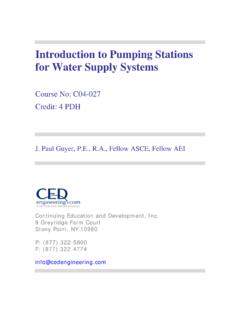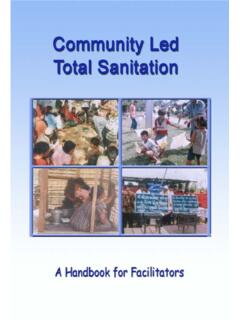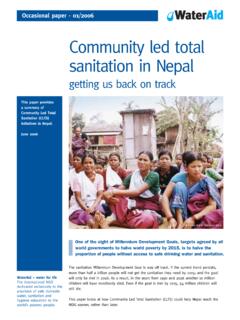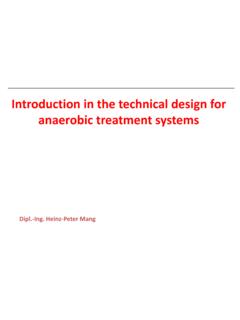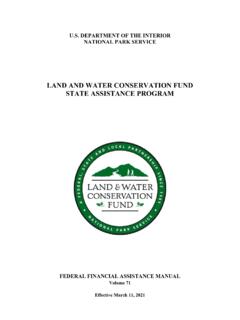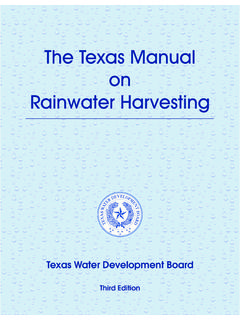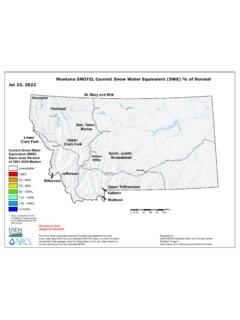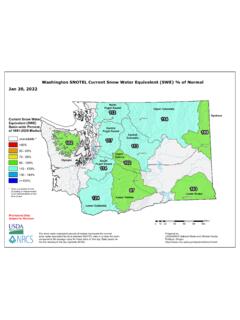Transcription of Water conservation in textile industry - SSWM
1 48 PTJ November 2009 The textile industry is in no way different than other chemicalindustries, which causes pollution of one or the other type. Thetextile industry consumes large amount of Water in its varied pro-cessing operations. In the mechanical processes of spinning andweaving, Water consumed is very small as compared to textilewet processing operations, where Water is used all dyes, specialty chemicals, and finishing chemicals areapplied to textile substrates from Water baths. In addition, mostfabric preparation steps, including desizing, scouring, bleaching,and mercerizing use aqueous systems.
2 According to USEPA a unitproducing 20,000 Ib / day of fabric consume 36000 liters textile wet processing, Water is used mainly for two pur-poses. Firstly, as a solvent for processing chemicals and secondly,as a washing and rinsing medium. Apart from this, some Water isconsumed in ion exchange, boiler, cooling Water , steam dryingand industry is being forced to consider Water conservationfor many reasons. The primary reasons being the increased com-petition for clean Water due to declining Water tables, reducedsources of clean waters, and increased demands from both indus-try and residential growth, all resulting in higher costs for this nat-ural resource.
3 Water and effluent costs may in the more commoncases, account for as much as 5% of the production usageWater usage at textile mills can generate millions of gallons ofdye wastewater daily. The unnecessary usage of Water adds sub-stantially to the cost of finished textile products through increasedcharges for fresh Water and for sewer quantity of Water required for textile processing is largeand varies from mill to mill depending on fabric produce, process,equipment type and dyestuff. The longer the processingsequences, the higher will be the quantity of Water required.
4 Bulkof the Water is utilized in washing at the end of each process. Theprocessing of yarns also requires large volumes of Water . Thewater usage of different purposes in a typical cotton textile milland synthetic textile processing mill and the total Water consumedduring wet process is given in table 1 and table 2 variation is observed in consumption mainly due to theuse of old and new technologies and difference in the processingsteps followed types of machines textile processor should have knowledge of the quantityof Water used for processing.
5 The volume of Water required foreach process is tabulated as under: Water conservation in textile industryby Muhammad Ayaz Shaikh, Assistant Professor, College of textile Engineering, 1: Water usage in textile millsPurposePercent Water useCotton textileSynthetic textileSteam or ROwater for specific Water fire 2: Total Water consumed during wet processingProcessPercent Water consumedBleaching38%Dyeing16%Printing8%B oiler14%Other uses24%Table 3: Water requirements for cottontextile wet finishing operationsProcessRequirements in litres/1000 kg of productSizing500-8200 Desizing2500-21000 Scouring20000-45000 Bleaching2500-25000 Mercerizing17000-32000 Dyeing10000-300000 Printing8000-16000 Table 4.
6 Water requirements for synthetictextiles wet finishing operationsProcessRequirements in Litre/1000 kg of productRayonAcetateNylonAcrylic/Modacryl icPolyesterScouring17000-3400025000-8400 050000-6700050000-6700025000-42000 Salt bath4000-12000--------Bleaching--33000-5 0000------Dyeing17000-3400034000-5000017 000-3400017000-3400017000-34000 SpecialFinishing4000-1200024000-40000320 00-4800040000-560008000-12000 Washing efficiencyWashing process is characterized by its washing efficiencythat is the amount of the compound that is removed divided bythe total amount that could have been removed.
7 Washing effi-ciency is not directly dependent on the amount of Water used butis a function of: Temperature Speed of fabric in the washing range The properties of the fabric The properties of the washing rangeTemperatureThe temperature is important in washing because the temper-ature influences;a. The viscosity of Water . At a lower viscosity Water can betterpenetrate through the fabric and washing will become The affinity of compounds. At a higher temperature the affin-ity decreases and results in a better washing away of theunwanted of the components from the inner fibre to thewater around the fiber.
8 This migration is important for thetotal time the washing process will of fabric in the washing rangeThe speed of fabric in the washing range determines theamount of Water that is hanged in the fabric by passing a roller inthe washing compartment. That is the liquor that was in the fabricbefore passing the roller with a high concentration of theunwanted components that is replaced by the washing liquorwith a low concentration of the unwanted properties of the fabricThe properties of fabric influence the washing effectivenessby the amount of Water that can be pressed through the fabricduring washing.
9 The openness of the fabric as well as the open-ness of yarn determines the length of the way the unwantedcomponent has to migrate to the fluid that can be exchanged inthe washing process. In the washing process generally only verylittle Water from the pores between the fibres is exchanged whenthe yarns are strongly twisted this will be practically zero. Asmigration is a very slow process it will take much longer for all thecomponents to be washed out. The same holds more or less forthicker yarns and heavy weight properties of the washing rangeThe effectiveness of the washing range is determined by thenumber of washing tanks, the number of compartments in eachtank, the diameter of the roller and the way the fabric is led throughthe washing range.
10 The washing effectiveness can be improved byplacing rollers on top of the top-rollers. This squeeze off the excesswater in the fabric and a better exchange of washing liquid will berealized. Also at high speed these top rollers will prevent Water to betaken with the fabric to the next compartment. Water conservation and reuseWater is expensive to buy, treat, and dispose. If the industry doesnot have Water conservation program, its pouring money downs thedrain. Now, Water conservation and reuse are rapidly becoming anecessity for textile industry .



